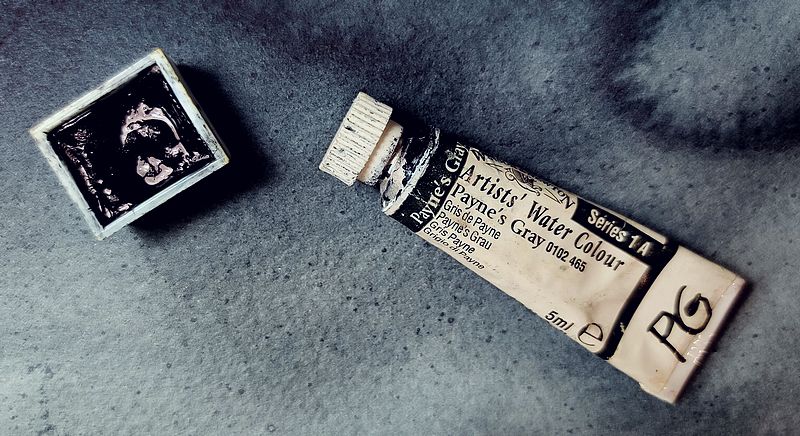Paynes Gray (mixed color)

William Payne (1760–1830) was an English artist who liked to paint landscapes with a blue-gray haze, magical landscapes with dramatic cliffs, fantastic waterfalls and dangerous forests. Everything very romantic. He used a color he mixed with Prussian blue, a little yellow ocher and a splash of Madder Lake Red. This warm blue-gray color became the artist’s characteristic and later became well known under the name “Paynes gray”.
The mix has been used by other artists since Payne’s time. The first recorded use of Payne’s gray as a color name was in 1835.
Today the color is mixed differently, usually with black + some blue and maybe a little red or violet. Unfortunately, often with the dull Lamp black and the equally dull phthalo blue, but there are manufacturers who use e.g. Ivory black + ultramarine that gives a more lively result. In the book “Guide to Watercolor Paint”, Hilary Page wrote about Paynes gray: “Dull is the operative word. It really adds a dullness to a painting ”, that’s it, no painting is so boring that it can not be made more bland with the help of Paynes gray.
Some artists who do not use black (they have learned that at some point) use Paynes gray instead and think that they do not use black. That’s not the case, black is included in almost all versions of the color, not only that, it is by far the largest ingredient.
The manufacturers have, almost all, different ways to achieve the perfect Paynes gray, they are very different with color tones from blue-violet to almost neutral, all dull and blackish. Some are neutral in tone while others are more colorful. Because the different mixtures are so different, it is impossible to describe what Paynes gray looks like, it has the look that the manufacturer wants, different choices of pigments make all versions different, with completely different properties. If you own a black color, mix it with any blue and you have created your variant of Paynes gray. If you add a little red color, you will be closer to the original.
Here is a list of some different manufacturers’ versions of Paynes Gray, as you can see the colors are quite different.

BLOCKX
Iron black PBk11
Ultramarine PB29
Phthalo blue PB15:1

WINSOR & NEWTON : COTMAN
Ultramarine PB29
Lamp black PBk7
Phthalo blue PB15

DALER ROWNEY Aquafine
Lamp black PBk7
Ultramarine PB29

DALER ROWNEY
Lamp black PBk7
Ultramarine PB29

DANIEL SMITH PAYNE’S BLUE GREY
Indanthrone blå PB60
Lamp black PBk6

DANIEL SMITH PAYNES GRAY
Ultramarine PB29
Ivory black PBk9

HOLBEIN PAYNES GREY
Lamp black PBk6
Phthalo blue PB15
Quinacridone magenta PR122

LUKAS
Benzimidazolone carmine PR176
Phthalo blue PB15:1
Lamp black PBk7

MAIMERIBLU
Ultramarine PB29
Ivory black PBk9

OLD HOLLAND
Ultramarine PB29
Ivory black PBk9

SCHMINCKE
Lamp black Pbk6
Phthalo blue (RS) PB15:6
Phthalo blue (GS) PB15:2

SENNELIER
Phthalo blue PB15:1
Lamp black PBk7
Quinacridone rosa PV19

ST PETERSBURG : WHITE NIGHTS
Lamp black PBk7
Phthalo blue PB15
Methyl Violet PV.3

ROYAL TALENS : REMBRANDT
Lamp black PBk6
Phthalo blue PB15

WINSOR & NEWTON
Phthalo blue PB15
Lamp black PBk6
Quinacridone rosa PV19












What a useful, great post!